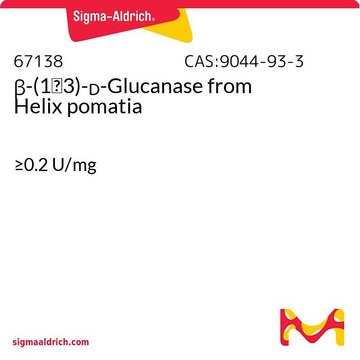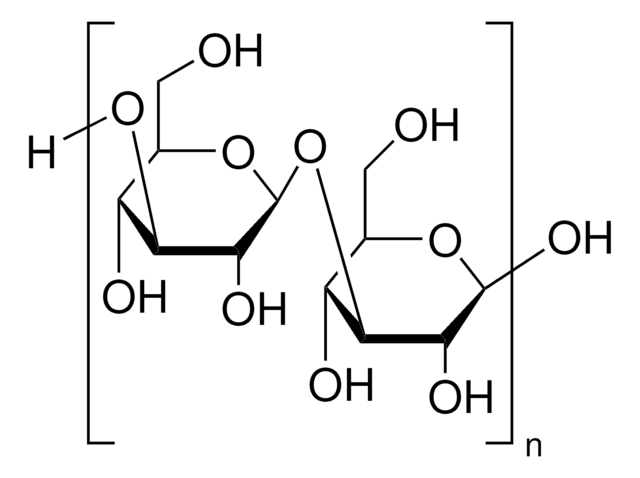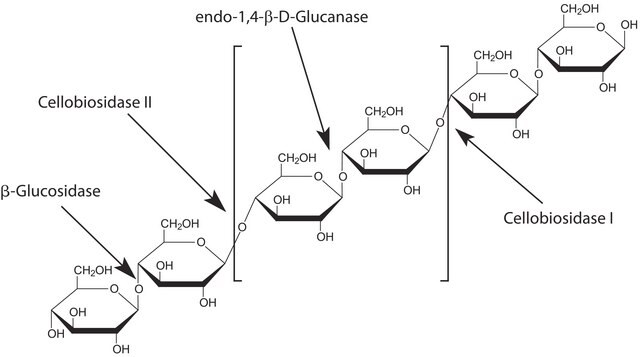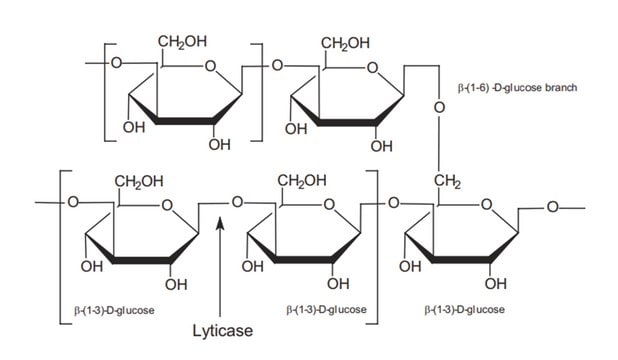49101
β-Glucanase from Aspergillus niger
powder, dark brown, ~1 U/mg
Autenticatiper visualizzare i prezzi riservati alla tua organizzazione & contrattuali
About This Item
Prodotti consigliati
Forma fisica
powder
Livello qualitativo
Attività specifica
~1 U/mg
Caratteristiche più verdi
Waste Prevention
Design for Energy Efficiency
Learn more about the Principles of Green Chemistry.
sustainability
Greener Alternative Product
Colore
dark brown
Categoria alternativa più verde
Temperatura di conservazione
2-8°C
Descrizione generale
We are committed to bringing you Greener Alternative Products, which adhere to one or more of The 12 Principles of Greener Chemistry. This product has been enhanced for energy eficiency and waste prevention when used in cellulosic ethanol research. For more information see the article in biofiles.
Azioni biochim/fisiol
β-glucanases degrade β-1,4-glucans of cellulose, xyloglucan and β-1,4-xylan.
Definizione di unità
One unit corresponds to the amount of enzyme which will release 1 μmole of reducing sugar equivalents (expressed as glucose) per minute at pH 5.0 and 55 °C, using β-D-glucan (Cat. No. 49102) as substrate
Avvertenze
Danger
Indicazioni di pericolo
Consigli di prudenza
Classi di pericolo
Resp. Sens. 1
Codice della classe di stoccaggio
11 - Combustible Solids
Classe di pericolosità dell'acqua (WGK)
WGK 1
Punto d’infiammabilità (°F)
Not applicable
Punto d’infiammabilità (°C)
Not applicable
Dispositivi di protezione individuale
Eyeshields, Gloves, type N95 (US)
Certificati d'analisi (COA)
Cerca il Certificati d'analisi (COA) digitando il numero di lotto/batch corrispondente. I numeri di lotto o di batch sono stampati sull'etichetta dei prodotti dopo la parola ‘Lotto’ o ‘Batch’.
Possiedi già questo prodotto?
I documenti relativi ai prodotti acquistati recentemente sono disponibili nell’Archivio dei documenti.
I clienti hanno visto anche
Yigang Teng et al.
Acta biochimica et biophysica Sinica, 42(10), 729-734 (2010-09-28)
In this study, we confirmed that at least three endo-β-1,4-glucanases existed in the digestive juice of the giant snail, Achatina fulica ferussac, by Congo red staining assay. One of these enzymes, a novel endo-β-1,4-glucanase (AfEG22), was purified 29.5-fold by gel
Juntao Sun et al.
Biotechnology letters, 33(11), 2193-2199 (2011-07-08)
A new fusion gene (Bgl-licMB), encoding β-1,3-1,4-glucanase both from Bacillus amyloliquefaciens (Bgl) and Clostridium thermocellum (licMB), was constructed via end-to-end fusion and expressed in Escherichia coli to improve hydrolytic activity and thermostability of β-1,3-1,4-glucanase. The results of enzymatic properties showed
Nhuan P Nghiem et al.
Applied biochemistry and biotechnology, 165(3-4), 870-882 (2011-06-15)
A fermentation process, which was designated the enhanced dry grind enzymatic (EDGE) process, has recently been developed for barley ethanol production. In the EDGE process, in addition to the enzymes normally required for starch hydrolysis, commercial β-glucanases were used to
Chengwei Hua et al.
Applied microbiology and biotechnology, 88(2), 509-518 (2010-07-21)
In this study, a novel beta-1,3-1,4-glucanase gene (designated as PtLic16A) from Paecilomyces thermophila was cloned and sequenced. PtLic16A has an open reading frame of 945 bp, encoding 314 amino acids. The deduced amino acid sequence shares the highest identity (61%)
C J O'Shea et al.
Journal of animal science, 88(4), 1411-1420 (2009-12-22)
The objective of the current experiment was to evaluate the influence of dietary cereal sources of beta(1,3)(1,4)-d-glucan (beta-glucan) and enzyme supplementation on indices of environmental pollution from finisher pigs. An experiment with a 2 x 2 factorial arrangement of treatments
Il team dei nostri ricercatori vanta grande esperienza in tutte le aree della ricerca quali Life Science, scienza dei materiali, sintesi chimica, cromatografia, discipline analitiche, ecc..
Contatta l'Assistenza Tecnica.







